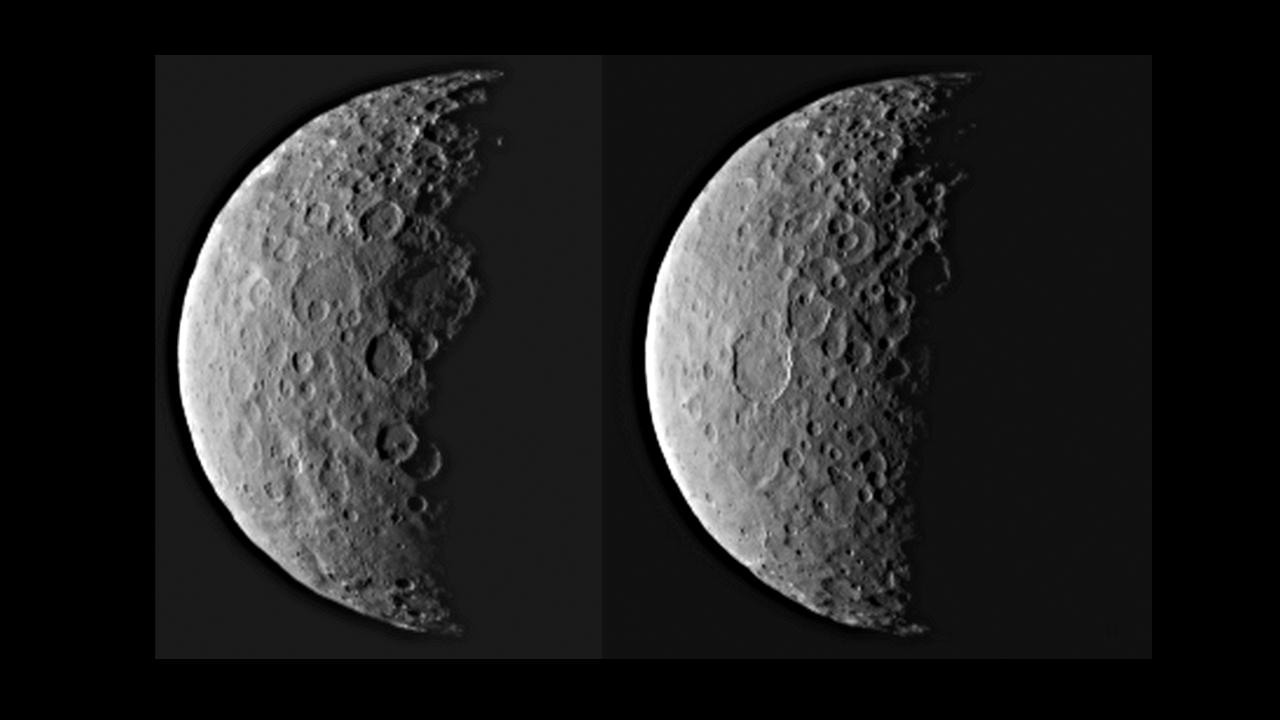
NASA's Dawn probe has begun orbiting Ceres, but the spacecraft still has some traveling to do before it starts taking the dwarf planet's measure.
Dawn arrived at Ceres early Friday morning (March 6), becoming the first spacecraft ever to circle a dwarf planet, as well as the first to orbit two bodies beyond the Earth-moon system. (Dawn studied the protoplanet Vesta up close from July 2011 through September 2012.)
But Dawn is still on the move, and will be for another six weeks, when the spacecraft reaches a position to begin making science observations. [Read more coverage of Dawn's Ceres arrival]
Dawn "is working now to reshape its orbit around Ceres," Dawn mission director and chief engineer Marc Rayman, who's based at NASA's Jet Propulsion Laboratory (JPL) in Pasadena, California, wrote in a blog post Friday.
The spacecraft's "orbital acrobatics first will take it up to an altitude of 47,000 miles (75,000 kilometers) on March 19 before it swoops down to 8,400 miles (13,500 km) on April 23 to begin its intensive observations in the orbit designated RC3," Rayman added. (Dawn was about 37,700 miles, or 60,600 km, from Ceres when it was captured by the dwarf planet's gravity on Friday.)

Dawn's current trek is so leisurely because the probe uses low-thrust, hyperefficient ion engines rather than a traditional chemical-propulsion system.
"If you hold a single piece of paper in your hand, the paper will push on your hand as hard as the ion engine pushes on the spacecraft," Rayman said during a news conference Friday.
Get the Space.com Newsletter
Breaking space news, the latest updates on rocket launches, skywatching events and more!
So the world will have to wait a little while to get its first big Ceres fix. Indeed, Dawn is currently on the dwarf planet's dark side and won't even beam home any new photos of Ceres until April 10, Rayman said.
The $473 million Dawn mission launched in September 2007 to study Vesta and Ceres, the two largest objects in the main asteroid belt between Mars and Jupiter. Vesta is 330 miles (530 km) wide, while Ceres' diameter is estimated at 590 miles (950 km).
Both objects are intact protoplanets whose further growth was halted by Jupiter's immense gravitational tug. So Dawn's observations should yield insights into the solar system's early days and how rocky planets such as Earth are put together, mission team members have said.
Dawn will map Ceres' surface in great detail, helping researchers determine what the dwarf planet is made of and yielding insights about how it formed. The spacecraft will also investigate Ceres' mysterious bright spots — which are likely deposits of either water ice or salts — and seek to confirm and characterize water-vapor plumes spotted recently by Europe's Herschel Space Observatory.
Dawn will perform this work through June 30, 2016, from a series of four science orbits that will be successively closer to the dwarf planet. The final orbit, which Dawn should reach this December, will take the probe within just 230 miles (370 km) of Ceres' cratered surface.
"By the time we finish in mid-2016, we're going to know Ceres in exquisite detail," Dawn Deputy Principal Investigator Carol Raymond, also of JPL, said during Friday's news conference. "We're going to understand why it has very, very bright spots — which are unique to any body in the solar system that has been explored thus far — and we're going to understand what Ceres means in terms of a building block for planets in our solar system."
Ceres is also interesting astrobiologically: The dwarf planet probably once had a subsurface ocean, which may have been capable of supporting life as we know it, Raymond said. (Some researchers, in fact, think Ceres might still harbor some underground liquid water.)
So Raymond and her colleagues are excited to see just what Dawn discovers over the next 16 months.
"We've been creeping up on Ceres for months, and the anticipation has been growing," Raymond told the Slooh Community Observatory during a Ceres webcast on Friday. "This is certainly a big milestone for us, but mainly, we're already in the frame of mind that Dawn is at Ceres. We've been getting some beautiful data images … and it's looking like a very interesting world, so we're all very anxious to get a better look."
Follow Mike Wall on Twitter @michaeldwall and Google+. Follow us @Spacedotcom, Facebook or Google+. Originally published on Space.com.
Join our Space Forums to keep talking space on the latest missions, night sky and more! And if you have a news tip, correction or comment, let us know at: community@space.com.

Michael Wall is a Senior Space Writer with Space.com and joined the team in 2010. He primarily covers exoplanets, spaceflight and military space, but has been known to dabble in the space art beat. His book about the search for alien life, "Out There," was published on Nov. 13, 2018. Before becoming a science writer, Michael worked as a herpetologist and wildlife biologist. He has a Ph.D. in evolutionary biology from the University of Sydney, Australia, a bachelor's degree from the University of Arizona, and a graduate certificate in science writing from the University of California, Santa Cruz. To find out what his latest project is, you can follow Michael on Twitter.









